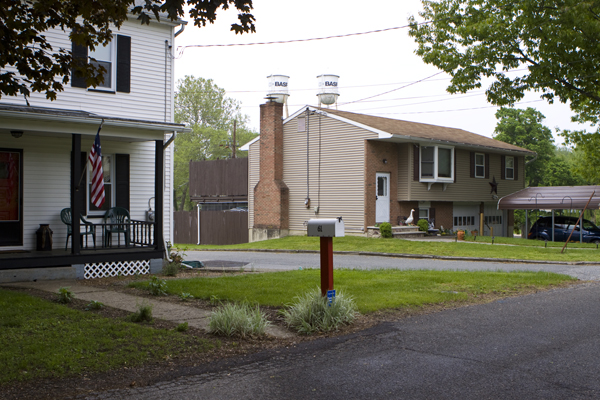
Kuehne Chemical, Kearny, NJ. Accident would kill over 100,000 people. Note chemical industry “Responsible Care” PR logo. Is it responsible to pose this kind of fatal threat to 12 million people living in an urban area?
Last Thursday marked the 25th anniversary of the Bhopal India chemical disaster, where more than 4,000 people were immediately killed by accidental release of a toxic gas (methyl isocyanate) from a Union Carbide chemical plant. Perhaps 10,000 more people died within 3 days, while thousands more were poisoned and suffered greatly.
The Bhopal disaster was not an isolated episode or unique third world threat. A similar – or worse accident – could happen here.
In fact, in 1995, it did happen here at Knapp Chemical in Lodi NJ, where a chemical explosion killed 4 workers and forced evacuation of the community (link – scroll down to “Environmental News”).
Right here in the US, a minor methyl isocyanate leak occurred in Middleport, New York, in November 1984. A sister Union Carbide methyl isocyanate (MIC) production plant is located in Institute, West Virginia.
In the wake of the Bhopal disaster, NJ passed the Toxic Catastrophe Prevention Act, to strictly regulate extraordinarily hazardous chemicals. The TCPA law created a DEP regulatory program to oversee and manage chemical safety at over 100 NJ chemical plants.
But since Bhopal, we’ve learned that accidental chemical plant risks have been magnified greatly by the threat of terrorism.
Yet DEP regulation and government oversight has not increased to respond to those risks – rather, despite promises by then Senator and now Governor Jon Corzine, management of these risks has been privatized, shrouded in secrecy, and made voluntary. see:
- New Chemical Plant Safety Rules Rely on Voluntary Measures
- Chemical (In)Security – Industry Profits Trump Community Safety
- NY Times: “Corzine’s Chemical Security Stance Draws Scrutiny a Year Into His New Job“
Here in NJ, EPA estimates an accident or terror attack could kill over 100,000 people (each) at more than 15 New Jersey chemical plants (see Report/list of facilities here)
This fact might come as a big surprise to the communities that host these plants and the neighbors who live nearby those plants, in the “kill zone”. These communities are largely kept in the dark, as the “kill zones” maps are kept secret.
So, below are photo’s of those plants and a Report/list of facilities here) providing documentation of the risks and recommendations for stronger management.
At some point, we must consider whether the inherent risks of having dangerous chemical plants (which are impossible to secure) nearby densely populated cities and residential neighborhoods are unacceptable.
I believe that they are and that these plants should be shut down and relocated to remote areas where population density and human health and safety risks are minimal.
(here’s some of the most Fatal Fifteen – don’t be fooled by the pretty landscaping and white tanks!)


Valero Refinery, right next door to Paulsboro High School

Dupont Chambers Works – Deepwater, NJ

Basel USA – Edison, NJ


BASF – Belvidere, NJ

Pingback: maillot argentine mondial 2014
Pingback: hogan outlet on line
Pingback: camiseta de brasil 2013
Pingback: hogan 2014
Pingback: nuevo jersey del real madrid 2014
Pingback: outlet hogan online
Pingback: uitshirt ajax bestellen
Pingback: hogan prezzo
Pingback: Cheap NFL Jerseys
Pingback: prada outlet
Pingback: spaccio hogan
Pingback: hogan outlet serravalle
Pingback: hogan scarpe donna
Pingback: hogan outlet online
Pingback: crear una camiseta de barcelona
Pingback: 小泻邪褔邪褌褜 斜械褋锌谢邪褌薪芯 mac lipstick sin matte Beautiful KUXJU 768 鈥?芦 小泻邪褔邪褌褜 Java 袠谐褉褘 薪邪 褌械谢械褎芯薪. 袣邪褉褌懈薪泻懈, 褌械泻褋褌褘 褋屑褋, 褉懈薪谐褌芯薪褘,
Pingback: dekorasik official
Pingback: WolfeNotes.com » A Shameful Toxic Legacy: From Lodi And Paulsboro, NJ To Palestine, Ohio